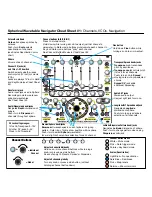
66
The Editor View
distinguished anymore and can be assimilated to an exponentially decaying signal. The first part
of the room response is called the early reflexion while the second is called the late reverberation.
The total duration of the room response is called the reverberation time (RT).
Figure 41: Impulse response of a room.
Adjusting the room effect
The size of a room strongly affects the reverberation effect. The
Size
selector is used to choose be-
tween the
Studio
,
Club
,
Hall
and
Large Hall
settings each reproducing spaces of different volumes
from smaller to larger.
The duration of the reverberation time depends on both the size of the room and the absorption
of the walls, which is controlled with the
Decay
knob. In a real room the reverberation time is not
constant over the whole frequency range. As the walls are often more absorbent in the very low and
in the high frequencies the reverberation time is shorter for these frequencies. These parameters
are adjusted with the
Low
and
High
knobs respectively.
Another parameter which affects the response of a room is its geometry; the more complex
the geometry of a room, the more reflexion are observed per unit of time. This quantity is known
as the time density and can be set trough the
Diffusion
knob. In a concert hall, the time density
is supposed to be quite high in order not to hear separate echoes which are characteristic of poor
sounding rooms. The last parameter which affects our listening experience in a room, is the distance
between the sound source and the listener. While the room response is quite constant regardless of
the position of the source and the listener, the direct sound (the sound which comes directly from
Содержание ULTRA ANALOG VA-3
Страница 1: ...USER MANUAL ...
Страница 18: ...18 Architecture of Ultra Analog VA 3 Figure 11 The Settings view ...










































